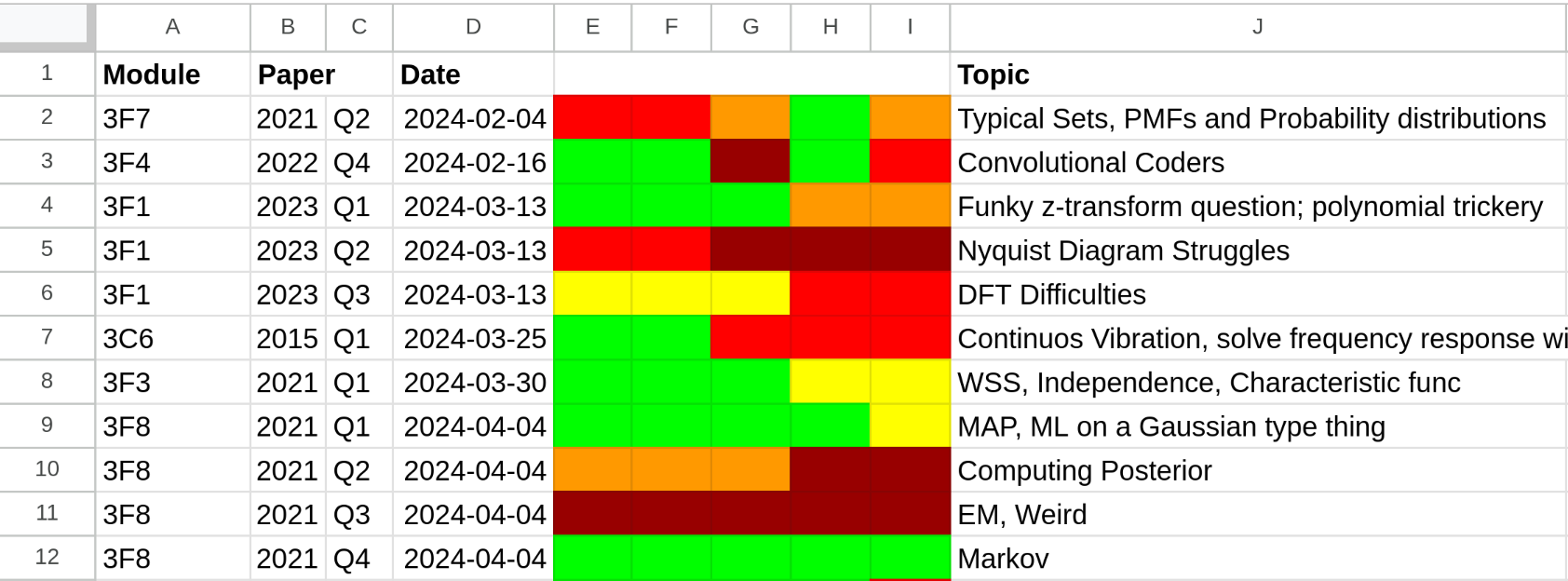gyromagnetic ratio has the symbol ...
How I Beat Cambridge
The science shows that the optimal learning involves active recall, spaced repetition and mixed practice. I worked really hard to structure my study around these ideas, and I think spaced repetition systems are underused when studying for Engineering.
This post is my honest and detailed reflection on the spaced repetition techniques that helped me succeed at university. I hope it is helpful to you!
Anki
The long term backbone of my study was pretty much entirely done through Anki, with flashcard reviews being my first priority during self study time. I did virtually all of my reviews on the Anki Desktop app, with small number of reviews done on the Ankidroid Android app.
Writing Flashcards
Some of the flashcards I write are shockingly basic. I even wrote a custom Anki note type to speed up the process of churning out the simplest flashcards:
gyromagnetic ratio has the symbol ...
\(\ll\) is the symbol for ...
Specific gas constant has the symbol ...
These cards seem trivial, but they're actually quite significant. Reviewing them gives your brain almost a level of fluency, and scaffolding for higher level ideas to sit on top of. These flashcards are lowest hanging fruit, and are maybe 10% of the flashcards that I write.
If the lecture is a little slow, I also write other basic flashcards. These are things that the lecturer clearly signposts, typically formulated like like "Recall X" or "Define Y":
With online lectures, you have the time to pause and copy entire proofs as flashcards. These are the kinds of flashcards I write when I'm doing an examples paper, or I'm watching a lecture online:
- \( r_{XX}[k] \) is an even function, implying that the DTFT is real
- \( r_{XX}[k] \) is real, is real, implying conjugate symmetry \(S_X(f) = S_X(-f) ^*\)
Essential tools for writing flashcards:
MathPix. This is one of the few subscription services I bought at Uni and allows me to copy latex directly from screenshots of equations! I bought this partially because I hate crappy screenshots, and partially because I could edit equations to fit the flashcard. I'd really recommend this!
Image Occlusion Enhanced. An addon for Anki, allows you to create "fill in the blank" style image flashcards. Very useful for remembering annotations on diagrams, but I think you can also use these for screenshots of equations?
An Image editor. I used GIMP, but any will do. Useful for basic editing of screenshots that you put in flashcards.
I don't think AI is great at writing flashcards (yet!). Don't get me wrong, AI is fantastic at helping you understand a topic, but AI generated flashcards are often poorly formulated and only cover surface level concepts. Instead, I usually give AI tools clearly defined tasks. I might give ChatGPT the front of a flashcard and get it to generate the back, or ask it to transform existing content, eg. "add colors to this equation to make the proof more comprehensible":
Reviewing Flashcards
After you write your flashcards, you also have to consistently review your cards. It is hard. Spaced repetition systems test you specifically on content you are on the verge of forgetting, and retrieval is challenging. Reviewing flashcards took about 30-40 minutes of focused work most days, and it felt like alot of work.
I wrote a script to visualize my flashcard reviews across four years at Cambridge. I've split out Michaelmas/Lent/Easter term times and vacations into five different blocks to show you how the year went:
First and second years are quite similar: Lectures most of the year and huge exams at the very end. Since flashcards pile up, the workload is naturally heavier in Lent term than in Michaelmas.
I think I got into the swing of things properly in third year. I focused on applying to internships, letting myself fall behind in Michalemas and pick up alot of the slack in Lent. Lent term bioengineering modules are particularly grim, I wrote 500 flashcards for 3G4 alone.
Fourth year has alot of coursework, and I reviewed by far the fewest amount of flashcards here.
Exam practice
Everybody has their own spreadsheet to track exam question progress, and I'm quite fond of mine.

It's nothing really that remarkable. I just have a new row for every tripos question I do, where I draw a color for how well I did in each section of the question. The week before the exam, I would revisit questions I'd previously struggled at.
I plotted some graphs, made a pretty dashboard and found it to be a source of motivation for doing work. I looked at the graph of "number of questions done" pretty much daily in exam season:

Bon Appétit
That's everything! This was a process that I consciously iterated on for four year of my life, it has been very productive for me and hope it has been useful to you. If you want learn more about spaced repetition systems, I have put together a reading list here. Feel free to reach out if you have any questions.